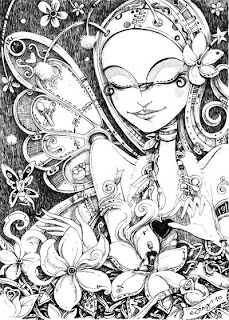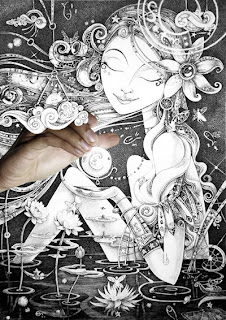Once upon a time, New York City had a Sixth Borough. You won’t read
about it in any of the history books, because there’s nothing – save
for the circumstantial evidence in Central Park – to prove that it was
there at all. Which makes its existence very easy to dismiss.
Especially in a time like this one, when the world is so
unpredictable, and it takes all of one’s resources just to get by in
the present tense. But even though most people will say they have no
time or reason to believe in the Sixth Borough, and don’t believe in
the Sixth Borough, they will still use the word “believe.”
The Sixth Borough was an island, separated from Manhattan by a thin
body of water, whose narrowest crossing happened to equal the world’s
long jump record, such that exactly one person on earth could go from
Manhattan to the Sixth Borough without getting wet. A huge party was
made of the yearly leap. Bagels were strung from island to island on
special spaghetti, samosas were bowled at baguettes, Greek salads were
thrown like confetti. The children of New York captured fireflies in
glass jars, which they floated between the boroughs. The bugs would
slowly asphyxiate, flickering rapidly for their last few minutes of
life. If it was timed right, the river shimmered as the jumper crossed
it.
When the time finally came, the long jumper would run the entire width
of Manhattan. New Yorkers rooted him on from opposite sides of the
street, from the windows of their apartments and offices, from the
branches of the trees. And when he leapt, New Yorkers cheered from the
banks of both Manhattan and the Sixth Borough, cheering on the jumper,
and cheering on each other. For those few moments that the jumper was
in the air, every New Yorker felt capable of flight.
Or perhaps “suspension” is a better word. Because what was so
inspiring about the leap was not how the jumper got from one borough
to the other, but how he stayed between them for so long.
One year – many, many years ago – the end of the jumper’s big toe
touched the surface of the water and caused a little ripple. People
gasped, as the ripple traveled out from the Sixth Borough back toward
Manhattan, knocking the jars of fireflies against one another like
wind chimes.
“You must have gotten a bad start!” a Manhattan councilman hollered
from across the water.
The jumper nodded no, more confused than ashamed.
“You had the wind in your face,” a Sixth Borough councilman suggested,
offering a towel for the jumper’s foot.
The jumper shook his head.
“Perhaps he ate too much for lunch,” said one onlooker to another.
“Or maybe he’s past his prime,” said another, who’d brought his kids
to watch the leap.
“I bet his heart wasn’t in it,” said another. “You just can’t expect
to jump that far without some serious feeling.”
“No,” the jumper said to all of the speculation. “None of that’s
right. I jumped just fine.”
The revelation traveled across the onlookers like the ripple caused by
the toe, and when the mayor of New York City spoke it aloud, everyone
sighed in agreement: “The Sixth Borough is moving.”
Each year after, a few inches at a time, the Sixth Borough receded
from New York. One year, the long jumper’s entire foot got wet, and
after a number of years, his shin, and after many, many years – so
many years that no one could even remember what it was like to
celebrate without anxiety – the jumper had to reach out his arms and
grab at the Sixth Borough fully extended, and then, sadly, he couldn’t
touch it at all. The eight bridges between Manhattan and the Sixth
Borough strained and finally crumbled, one at a time, into the water.
The tunnels were pulled too thin to hold anything at all.
The phone and electrical lines snapped, requiring Sixth Boroughers to
revert to old-fashioned technologies, most of which resembled
children’s toys: they used magnifying glasses to reheat their
carry-out; they folded important documents into paper airplanes and
threw them from one office building window into another; those
fireflies in glass jars, which had once been used merely for
decorative purposes during the festivals of the leap, were now found
in every room of every apartment, taking the place of artificial
light.
The very same engineers who dealt with the Leaning Tower of Pisa were
brought over to assess the situation.
“It wants to go,” they said.
“Well, what can you say about that?” the mayor of New York asked.
To which they replied, “There’s nothing to say about that.”
Of course they tried to save it. Although “save” might not be the
right word, as it did seem to want to go. Maybe “detain” is the right
word. Chains were moored to the banks of the islands, but the links
soon snapped. Concrete pilings were poured around the perimeter of the
Sixth Borough, but they, too, failed. Harnesses failed, magnets
failed, even prayer failed.
Young friends, whose string-and-tin-can phone extended from island to
island, had to pay out more and more string, as if letting kites go
higher and higher.
“It’s getting almost impossible to hear you,” said the young girl from
her bedroom in Manhattan, as she squinted through a pair of her
father’s binoculars, trying to find her friend’s window.
“I’ll holler if I have to,” said her friend from his bedroom in the
Sixth Borough, aiming last birthday’s telescope at her apartment.
The string between them grew incredibly long, so long it had to be
extended with many other strings tied together: the wind of his yo-yo,
the pull from her talking doll, the twine that had fastened his
father’s diary, the waxy string that had kept her grandmother’s pearls
around her neck and off the floor, the thread that had separated his
great-uncle’s childhood quilt from a pile of rags. Contained within
everything they shared with one another were the yo-yo, the doll, the
diary, the necklace, and the quilt. They had more and more to tell
each other, and less and less string.
The boy asked the girl to say “I love you” into her can, giving her no
further explanation.
And she didn’t ask for any, or say, “That’s silly” or “We’re too young
for love” or even suggest that she was saying “I love you” because he
asked her to. Her words traveled the yo-yo, the doll, the diary, the
necklace, the quilt, the clothesline, the birthday present, the harp,
the tea bag, the table lamp, the tennis racket, the hem of the skirt
he one day should have pulled from her body. The boy covered his can
with a lid, removed it from the string, and put her love from him on a
shelf in his closet. Of course, he could never open the can, because
then he would lose its contents. It was enough just to know that it
was there.
Some, like that boy’s family, wouldn’t leave the Sixth Borough. Some
said: “Why should we? It’s the rest of the world that’s moving. Our
borough is fixed. Let them leave Manhattan.” How can you prove someone
like that wrong? And who would want to?
For most Sixth Boroughers, though, there was no question of refusing
to accept the obvious, just as there was no underlying stubbornness,
or principle, or bravery. They just didn’t want to go. They liked
their lives and didn’t want to change. So they floated away, one inch
at a time.
All of which brings us to Central Park.
Central Park didn’t used to be where it now is. It used to rest
squarely in the center of the Sixth Borough; it was the joy of the
borough, its heart. But once it was clear that the Sixth Borough was
receding for good, that it couldn’t be saved or detained, it was
decided, by New York City referendum, to salvage the park. (The vote
was unanimous. Even the most obdurate Sixth Boroughers acknowledged
what must be done.) Enormous hooks were driven deep into ground, and
the park was pulled, by the people of New York, like a rug across a
floor, from the Sixth Borough into Manhattan.
Children were allowed to lie down on the park as it was being moved.
This was considered a concession, although no one knew why a
concession was necessary, or why it was to children that this
concession must be made. The biggest fireworks show in history lighted
the skies of New York City that night, and the Philharmonic played its
heart out.
The children of New York lay on their backs, body to body, filling
every inch of the park as if it had been designed for them and that
moment. The fireworks sprinkled down, dissolving in the air just
before they reached the ground, and the children were pulled, one inch
and one second at a time, into Manhattan and adulthood. By the time
the park found its current resting place, every single one of the
children had fallen asleep, and the park was a mosaic of their dreams.
Some hollered out, some smiled unconsciously, some were perfectly
still.
Was there really a Sixth Borough?
There’s no irrefutable evidence.
There’s nothing that could convince someone who doesn’t want to be convinced.
But there is an abundance of clues that would give the wanting
believer something to hold on to: in the peculiar fossil record of
Central Park, in the incongruous pH level of the reservoir, in the
placement of certain tanks at the zoo (which correspond to the holes
left by the gigantic hooks that pulled the park from borough to
borough).
There is a tree – just 24 paces due east from the entrance to the
merry-go-round – into whose trunk are carved two names. They don’t
appear in any phone book or census. They are absent from all hospital
and tax and voting records. There is no evidence whatsoever of their
existence, other than the proclamation on the tree.
Here’s a fact: no less than 5 percent of the names carved into the
trees of Central Park are of unknown origin.
As all of the Sixth Borough’s documents floated away with the Sixth
Borough, we will never be able to prove that those names belonged to
residents of the Sixth Borough, and were carved when Central Park
still resided there, instead of in Manhattan. So some believe that
they are made-up names and, to take the doubt a step further, that the
gestures of love were made-up gestures. Others believe other things.
But it’s hard for anyone, even the most cynical of cynics, to spend
more than a few minutes in Central Park without feeling that he or she
is experiencing some tense in addition to just the present. Maybe it’s
our own nostalgia for what’s past, or our own hopes for what’s to
come. Or maybe it’s the residue of the dreams from that night the park
was moved, when all of the children of New York City exercised their
subconsciouses at once. Maybe we miss what they had lost, and yearn
for what they wanted.
There’s a gigantic hole in the middle of the Sixth Borough where
Central Park used to be. As the island moves across the planet, it
acts like a frame, displaying what lies beneath it.
The Sixth Borough is now in Antarctica. The sidewalks are covered in
ice, the stained glass of the public library is straining under the
weight of the snow. There are frozen fountains in frozen neighborhood
parks, where frozen children are frozen at the peaks of their
swings-the frozen ropes holding them in flight. The tzitzit of frozen
little Jewish boys are frozen, as are the strands of their frozen
mothers’ frozen wigs. Livery horses are frozen mid-trot, flea-market
vendors are frozen mid-haggle, middle-aged women are frozen in the
middle of their lives. The gavels of frozen judges are frozen between
guilty and innocent. On the ground are the crystals of the frozen
first breaths of babies, and those of the last gasps of the dying. On
a frozen shelf, in a closet frozen shut, is a can with a voice inside
it.
Inspiration is out there!
Adventure, too.~
Monday, 5 March 2012
Wednesday, 22 February 2012
Wednesday, 23 March 2011
Thursday, 17 March 2011
Sunday, 20 February 2011
Tuesday, 15 February 2011
Subscribe to:
Comments (Atom)



























